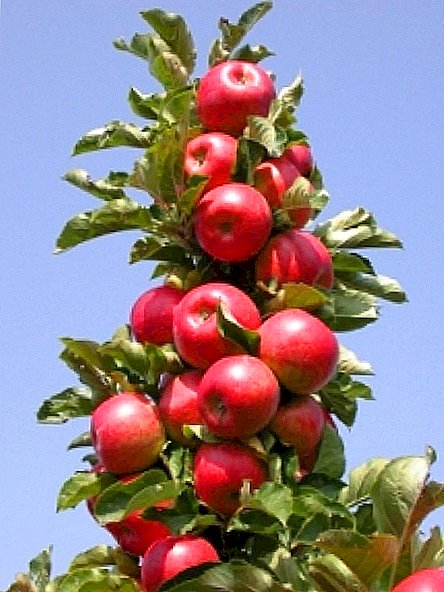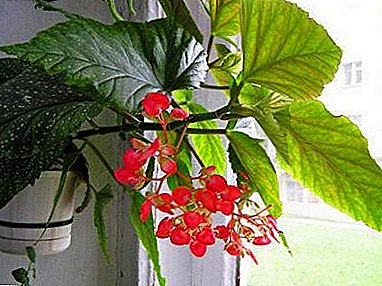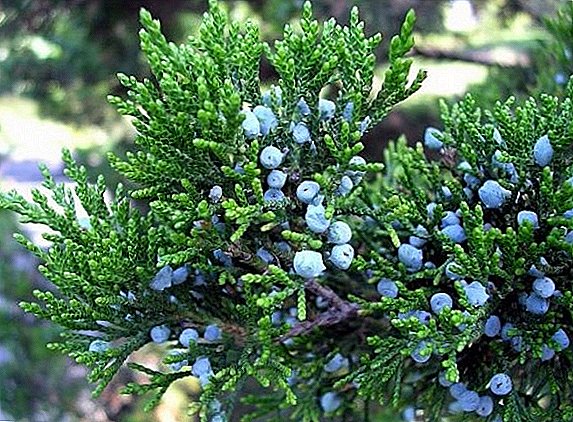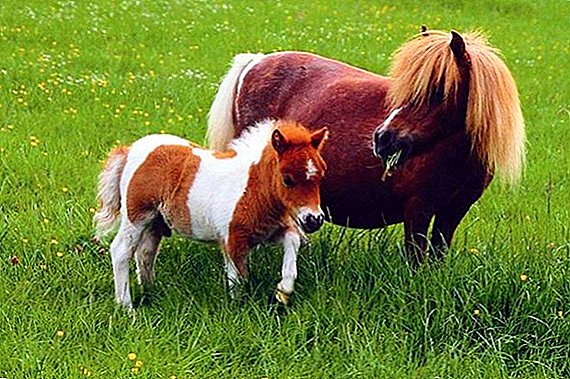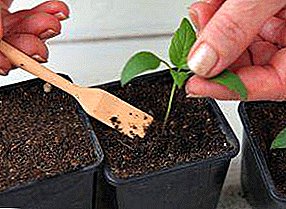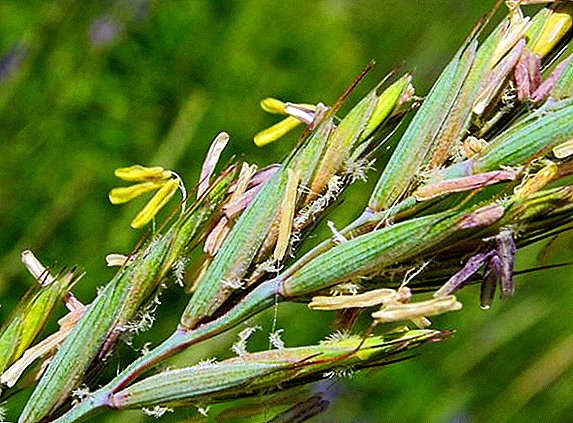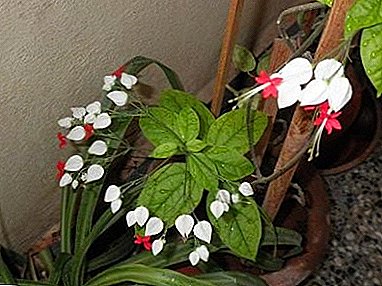
Clerodendrum (Clerodendrum) is an evergreen climbing plant belonging to the Verbenov family. Homeland of the plant is considered to be the tropics of Asia and Africa, as well as South America. In nature, there are about 400 species.
Clerodendrum has a few more names - Volkameria, Innocent Love, Tree of Fate. It is believed that this plant brings happiness to the owner.
Home care
 If you decide to purchase Klerodendrum, care at home is easy. Flowers of Clerodendrum are very fragrant and resemble the shape of butterflies.
If you decide to purchase Klerodendrum, care at home is easy. Flowers of Clerodendrum are very fragrant and resemble the shape of butterflies.
Since he has flexible and climbing vines, the plant is often used for vertical gardening. When pruning can achieve bushy plants.
At home it is necessary for the plant to provide comfortable conditions close to the wild habitat. With careful care, Clerodendrum will delight with long flowering.
Care after purchase
After buying a pot with a plant you need to establish a permanent place of growth. For quick adaptation, Clerodendrum needs to provide comfortable conditions.
First of all, you should take care of the lighting. Sunlight should be enough, it is a light-loving plant. But you should avoid direct rays that can harm the leaves.
Clerodendrum is also provided moderate watering and a temperature of about 20 ° C. After adaptation, which can last from 7 to 14 days, the plant can be transplanted into a new soil.
Pruning
On the plant it is necessary to remove dried twigs. In addition, annually, in early spring, pruning is done.
REFERENCE! To stimulate flowering and branching, shoots of a plant should be shortened by 1/3 of the length.
For creating bush forms shoots about 50 cm long should be left. After new side shoots appear, they need to pinch the tops, thereby forming a fluffy crown.
Pruning can be achieved tree shape. Remain 1-2 strong shoots height of 60-75 cm and cut all the side branches. In the upper part of the plant, pinching the tops of the young shoots is performed. And in the bottom, on the trunk, removed all the shoots.
Watering
 Since the natural habitat of Clerodendrum is tropics, it needs careful watering.
Since the natural habitat of Clerodendrum is tropics, it needs careful watering.
To moisten the soil, use only separated water at room temperature.
Before watering, the top layer of soil in the pot should dry out a bit.
Special attention should be paid to moisture. during flowering. Also during this period, every 2-3 days it is necessary to spray the leaves.
During the rest period, the frequency of watering the soil is reduced.
IMPORTANT! Even in winter, the soil in the pot should not be dry.
For additional moisture it is necessary to lay pebbles in the pan and periodically pour water into it.
Landing
For planting Clerodendrum earth mix can be purchased at the store. You can also cook it yourself. In relation to 2:1:1:1 mixed sheet soil, peat, clay soil and sand.
Pot for planting is taken spacious, slightly larger than the previous one. The bottom of the pot must be carpeted with a drainage layer. Claydite or broken red brick has good water permeability. Drainage in a pot should be about 5 cm.
Transfer
The indoor flower, Clerodendrum, is transplanted into a new pot every year, after pruning. An adult bush can be replanted as needed, but preferably 1 time in 2 years. During this procedure, the earth from the root system is not removed.
All earthy clod with roots transplanted into a pot, a little larger in size, and the prepared earth mixture is filled up. This method of handling is the safest for the roots.
If the plant needs support, then it is installed in the pot during transplantation.
Temperature
 In the summer months the temperature should not exceed + 25 ° C. In the winter months, during the period of rest, there is a partial dropping of leaves. At this time, Clerodendrum needs to provide a temperature of + 15-17 ° C.
In the summer months the temperature should not exceed + 25 ° C. In the winter months, during the period of rest, there is a partial dropping of leaves. At this time, Clerodendrum needs to provide a temperature of + 15-17 ° C.
In the rest period, the buds are laid. If it is not possible to lower the temperature in the room in winter, the flower pot can be put on the window sill closer to the glass.
Lighting
Clerodendrum loves bright diffused light. It is necessary to avoid direct sunlight. For constant growth fit windows facing east or west. Located at the south windows, you need to create a shadow. The northern windows will not have enough light.
Did you know that there are 4 of the most common types of Clerodendrum: Wallich, Ugandan, Philippine, and Thompson?
A photo
Admire the flowers of Clerodendrum grown at home can be in the photo:





Breeding
Cuttings
The easiest way to grow a plant is by cutting. To do this, cut a one-year sprout and put it in a jar of water until small roots appear. Then put in a pot.
You can also immediately plant in the pot, but the top must cover with a glass jar. Thus, a microclimate is created under the can. After the new leaves begin to appear, the jar can be removed.
Seeds
 Seeds are sown in rassadny boxes in the last decade of February or the first half of March. As an earthy mixture mixed in the same proportions of sod, humus and sand.
Seeds are sown in rassadny boxes in the last decade of February or the first half of March. As an earthy mixture mixed in the same proportions of sod, humus and sand.
Box after planting seeds covered with foil or glass. Periodically, to avoid drying out, the ground must be moistened. The temperature in the room with seedlings should be around 20 ° C.
After the appearance of 2-3 leaves, saplings are swooped in separate pots. Clerodendrum blooms the next year after planting seeds.
Benefit and harm
Clerodendrum does not possess any medicinal properties. It also does not harm. It can be grown in areas where there are small children and animals.
Application
Clerodendrum use for landscaping home or winter garden. It can be grown as a liana, thereby used for vertical gardening.
Diseases and pests
Plant with proper care is pretty rarely exposed to disease. When the soil dries out, the leaves turn yellow and fall. Spots of brown color can be formed with burns of tender leaves. Low air humidity may cause foliage and inflorescences to fall. With a lack of light, the plant stems are pulled out.
At the first appearance, the whole plant must be treated with a soap solution. If the treatment does not help, then it should be treated with insecticides.
Why does not bloom what to do?
 During the rest period it is necessary observe temperature conditions. If the temperature is above + 17 ° C, then the plant does not go to rest.
During the rest period it is necessary observe temperature conditions. If the temperature is above + 17 ° C, then the plant does not go to rest.
Because of this, Clerodendrum may not bloom. The rest period lasts from late November to February.
With proper care, Clerodendrum will delight with its interesting and delicate flowers for a long period. It will become a real living decoration of the house.


